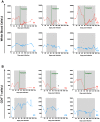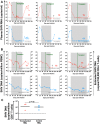Persistence of virus reservoirs in ART-treated SHIV-infected rhesus macaques after autologous hematopoietic stem cell transplant
- PMID: 25254512
- PMCID: PMC4177994
- DOI: 10.1371/journal.ppat.1004406
Persistence of virus reservoirs in ART-treated SHIV-infected rhesus macaques after autologous hematopoietic stem cell transplant
Abstract
Despite many advances in AIDS research, a cure for HIV infection remains elusive. Here, we performed autologous hematopoietic stem cell transplantation (HSCT) in three Simian/Human Immunodeficiency Virus (SHIV)-infected, antiretroviral therapy (ART)-treated rhesus macaques (RMs) using HSCs collected prior to infection and compared them to three SHIV-infected, ART-treated, untransplanted control animals to assess the effect of conditioning and autologous HSCT on viral persistence. As expected, ART drastically reduced virus replication, below 100 SHIV-RNA copies per ml of plasma in all animals. After several weeks on ART, experimental RMs received myeloablative total body irradiation (1080 cGy), which resulted in the depletion of 94-99% of circulating CD4+ T-cells, and low to undetectable SHIV-DNA levels in peripheral blood mononuclear cells. Following HSC infusion and successful engraftment, ART was interrupted (40-75 days post-transplant). Despite the observed dramatic reduction of the peripheral blood viral reservoir, rapid rebound of plasma viremia was observed in two out of three transplanted RMs. In the third transplanted animal, plasma SHIV-RNA and SHIV DNA in bulk PBMCs remained undetectable at week two post-ART interruption. No further time-points could be assessed as this animal was euthanized for clinical reasons; however, SHIV-DNA could be detected in this animal at necropsy in sorted circulating CD4+ T-cells, spleen and lymph nodes but not in the gastro-intestinal tract or tonsils. Furthermore, SIV DNA levels post-ART interruption were equivalent in several tissues in transplanted and control animals. While persistence of virus reservoir was observed despite myeloablation and HSCT in the setting of short term ART, this experiment demonstrates that autologous HSCT can be successfully performed in SIV-infected ART-treated RMs offering a new experimental in vivo platform to test innovative interventions aimed at curing HIV infection in humans.
Conflict of interest statement
The authors have declared that no competing interests exist.
Figures






References
-
- Finzi D, Hermankova M, Pierson T, Carruth LM, Buck C, et al. (1997) Identification of a reservoir for HIV-1 in patients on highly active antiretroviral therapy. Science 278: 1295–1300. - PubMed
-
- Hutter G, Nowak D, Mossner M, Ganepola S, Mussig A, et al. (2009) Long-term control of HIV by CCR5 Delta32/Delta32 stem-cell transplantation. N Engl J Med 360: 692–698. - PubMed
Publication types
MeSH terms
Substances
Grants and funding
LinkOut - more resources
Full Text Sources
Other Literature Sources
Research Materials

